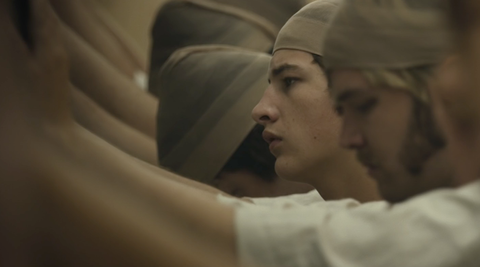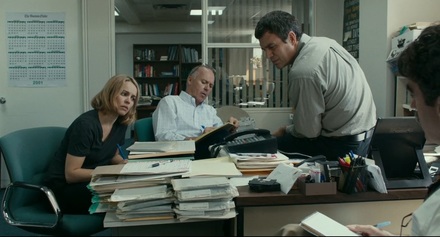
Famous psychological experiments invaded Sundance in 2015. Experimenter was a biopic about Stanley Milgram and his work with obedience and authority, and Stanford Prison Experiment chronicles Phillip Zimbardo's demonstration of how quickly power differentials lead to abuse. Where Experimenter takes a wider, cerebral view of Milgram's career, Stanford Prison Experiment lives in the few days the test was carried out, giving it a much more intense and claustrophobic feel.
Taking place in the early 70's, Dr. Zimbardo (Billy Crudup) and his subjects are the last students on the Stanford campus, as everyone else has left for the summer. In their solitude, the young men are divided into guards and prisoners, and for $15 a day, they are told to buy as much into their surroundings as they are able. Forced to wear emasculating uniforms and referred to only by numbers, the prisoners' discomfort and close quarters makes it easy for them to surrender to the illusion. The guards, dressed to look like something out of Cool Hand Luke and mildly agitated that the prisoners get to earn their money by just laying around, see the opportunity to spice up everyone's day. One guard (Michael Angarano) dives into the opportunity to play a role, adopting a cartoonish Southern accent and arbitrarily withholding necessary items from the prisoners. The other guards admire his gusto, and form a desire to top him, and a cycle of abuse and degradation is begun under the watchful eye of Zimbardo and his grad student assistants.
In response to the guards' abuse, prisoner 8612 (Ezra Miller) takes the lead in resisting. Fed up with the guards' behavior, he rallies other prisoners to fight back, organizing barricades in cells and escape attempts. While most of the prisoners are on his side, others just want to sit in their beds and earn their money. Both types of prisoners present more chances for mishandling, as the challenging prisoners invite more drastic punishment while the compliance of the docile prisoners invites the guards to try and find their internal line. Zimbardo is enamored with the results he's getting, and is unwilling to stop the experiment despite the protestations of his assistants, his girlfriend (Olivia Thirlby), and ex-con friend Jesse Fletcher (Nelsan Ellis), who he's brought in for verisimilitude. The stress of the situation makes all parties, including Zimbardo and his staff acting as wardens, blur the line between their continued discomfort and the fact that they can leave at any time.
Director Kyle Patrick Alvarez casts his film with seemingly every credible up-and-coming young male actor. In addition to The Knick's Anganaro and We Need to Talk About Kevin's Miller, Mud's Tye Sheridan, Parenthood's Miles Heizer, Animal Kingdom's James Frecheville, Palo Alto's Jack Kilmer, It Follows' Keir Gilchrist, and other veterans of coming-of-age indies have roles to play. The fraternal aspect that likely broke out on set amongst all these college-aged men lends a sense of realism to the guard-prisoner interactions, which bear striking resemblance to fraternity hazing. Memorization under duress, repetitive chants, forced physical activity, and a little sexual humiliation for good measure all make appearances. The dignity of the prisoners is never taken into consideration, including by some of the compliant prisoners themselves who assure their fathers that they are man enough to take the abuse while never wondering about the abuse's existence.
Of the adults in the room, Crudup and Ellis form a strong team. After Glass Chin and Spotlight, Crudup is cornering the market on Faustian characters, and his Zimbardo is yet another. He's acting in the part of Zimbardo who is also acting as the cold warden of the experimental prison, and Crudup is able to vacillate between these roles effortlessly. The concentrated masculinity of his experiment makes Zimbardo more aggressive, at one point looming over a professor who has some concerns. Ellis's Fletcher is a complicated character, a man affected by his stint in prison but willing to recreate the experience from the opposite side. The point of the experiment becomes lost as the subjects get further into it, but its value becomes harsh and cruel for Fletcher. Ellis gets at the pain of the character and steals the film from the deep cast.
Alvarez captures a feeling and transmits it to the viewer, a vital part of any successful film. Shooting in close-ups as much as possible, it becomes possible to feel the Stanford Prison Experiment invade the viewer's space. It pushes one back into their seat with its stomach-churning cruelty, and the empathetic performances serve to further amplify that feeling. The film is not a pleasant experience, but it is certainly a resonant one. B






 RSS Feed
RSS Feed